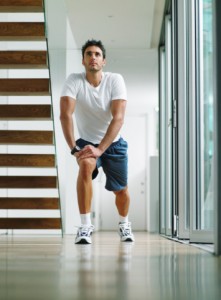 “Bodybuilding Stretching Exercises for Strength Training” article by Muscles Prod
“Bodybuilding Stretching Exercises for Strength Training” article by Muscles Prod
Most people imagine Bodybuilding Stretching Exercises to be muscle-bound, lacking in mobility and graceful posture. Indeed, many strength trainers who neglect to stretch do fit that image. Stretching is highly beneficial for anyone involved in strength training. Not only does it provide numerous health benefits but it can also enhance your muscle size and shape. This chapter gives you a thorough checklist on safe and effective stretching and explains exactly what happens in your muscles when you stretch. Finally, it gives you a step-by-step guide to the essential stretches that will benefit your workouts.
Why Bodybuilding Stretch?
The benefits of a good stretching programmed include:
- Reduced risk of muscle strain, joint injuries and back problems.
- Reduced post-exercise muscle soreness.
- Speedier recovery.
- Increased range of motion and co-ordination.
- Greater strength gains due to greater range of motion. improved body awareness.
- Better physical and mental relaxation.
How can stretching help enhance muscle size and shape?
Incorporating key stretches into your strength training programmed will result in greater muscle growth and the enhancement of muscle shape. Failing to stretch will not only, limit your range of motion but also your growth rate.
Stretching elongates the fascia, a strong protective sheath of connective tissue covering all muscles and their cells, allowing the muscle underneath room in which to grow. Fascia tissue can become thick and tough if the muscles are not stretched and are subjected to a limited range of motion. The best time to stretch the fascia is when the muscles are very’ warm and ‘pumped’ (i.e. full of blood). This occurs during and after a workout, so stretch between and after sets, and at the end of your training session.
Stretching increases flexibility, giving the muscles and joints a greater range of motion. It can1 prevent muscle soreness and promote faster recovery between workouts, helping to release1 lactic acid from the muscle cells into the bloodstream so that it does not hinder further: muscle contraction. Therefore, stretching! during your workout may enable you to train! harder and longer.
Stretching improves posture as well, and gives the body a more athletic or graceful appearance instead of that clumsy awkward gait that many bodybuilders develop.
How do muscles stretch?
The muscles contain receptors called muscle I spindles, which register information about the, muscle’s length and rate of change of length.
One of their main jobs is to protect the muscles from injury. So whenever there is a rapid change in muscle length, a reflex action is set up to shorten or contract it instead.
Tendons – which attach muscles to bone also contain receptors called golgi tendon organs (GTOs), registering information about the degree of tension in the tendon. When a high force is registered, the GTOs enable the muscle to relax in an attempt to reduce the tension, thus acting as a safety mechanism. If the intensity of a muscular contraction or stretch exceeds a certain critical point, an intermediate reflex occurs to inhibit the contraction or stretch. As a result, the muscle instantly relaxes and the excessive tension is removed, and with it the possibility of injury. In other words, the GTOs shut down the muscle to prevent injury. If the GTOs did not exist, it would be possible to have a stretch or contraction so powerful that the muscle or tendon would be torn from its attachments!
Bouncing, uncontrolled or forced movements cause the greatest reflex response. Thus ballistic stretching can cause the muscle to contract and so increase the chance of injury. Static stretching that is carried out slowly and in a controlled manner will lead to a reflex relaxation of the muscle.
Strength through stretching is related to your GTO threshold, which limits a contraction well short of the point at which tendons would be injured. Stretching gives the muscles the ability to contract more efficiently without shutting down in response to stretched tendons. Obviously, it is desirable to
have a high GTO reflex threshold, as this allows you to handle heavier weights and do more reps without the GTOs inhibiting muscle acton. The higher the GTO threshold, the more intensely you can train, and the greater the gains in size and strength. Stretching your muscles regularly can help raise your GTO threshold, some experts estimate, by up to 15-20%.
How to perform stretches
You should only stretch when your body is warm and the muscle is receiving an increased blood flow. Stretching a cold muscle increases the risk of injury and reduces the effectiveness of the stretch. Here are some basic guidelines:
- Ideally, stretching should be done after a workout and also in-between sets.
- Alternatively, stretch in-between workouts as a separate session but only after a thorough warm-up – 5-10 minutes of some light aerobic activity.
- Perform static stretches and avoid bouncing. This is a far safer method of stretching a muscle than ballistic movements.
- Gradually ease into position, all the time focusing on relaxing the muscle.
- Stretch only as far as is comfortable and then hold that position. As the muscle relaxes, ease further into the stretch, gradually increasing the range of motion.
- Never hold your breath. Exhale and relax as you go into the stretch and then breathe normally.
- Never go past the point of discomfort or pain. You could pull or tear the muscle/ tendon.
- Stretches performed at the end of a workout, or during a separate session, should be held for 30 seconds or more to allow stretching in the connective tissue and muscle.
- Release from the stretch slowly.
The Stretches
Quadriceps
- Hold on to a sturdy support.
- Bend one leg behind you and hold the ankle.
- Keep your thighs level, knees close, and push your hips forwards until you feel a good stretch.
- Repeat on the other side.
Adductors
- Sit on the floor and place the soles of your feet together.
- Hold on to your ankles and press your thighs down using your elbows. Keep your back straight.
Hamstrings
- Sit on the floor with one leg extended and the other leg bent.
- Keeping your back straight and flat, bend forwards from the hips. Reach down towards your foot.
- Flexing your foot will increase the stretch on the calf.
- Repeat on the other side.
Hip Flexors
- From a kneeling position, take a large step forwards so that your knee makes a 90° angle and is directly over your foot.
- Keep your body upright and press your rear hip forwards, keeping it square.
- Repeat on the other side.
Hips/glutes
- Sit on the floor and cross one foot over your straight leg.
- Place your elbow on the outside of the bent knee and slowly look over your shoulder on the side of the bent leg.
- Keep your opposite arm behind your hips for stability.
- Apply pressure to the knee with your elbow.
- Repeat on the other side.
Calves
- From a standing position, take an exaggerated step. forwards, keeping your rear leg straight. Hold on to a wall for support if you wish.
- Your front knee should be at 90° and positioned over your foot.
- Lean forwards slightly so that your rear leg and body make a continuous line.
- Repeat on the other side.
Neck
- In a seated position, take your hand and gently pull your head towards your shoulder – i.e. your ear towards your shoulder.
- Apply gentle pressure with your arm over your head.
- Repeat on the other side.
Upper Back
- Hold on to an upright support at waist height with your arms straight.
- Bend at the hips until your torso is parallel to the floor.
- Gently pull back, ensuring your back is flat.
Lower Back
- Lie on your back, knees bent and arms straight out to each side.
- Rotate both legs to each side, keeping your head, shoulders and arms in contact with the floor.
Shoulders
- Grab one elbow with your opposite hand.
- Gently pull it across your body, aiming the elbow towards the opposite shoulder.
- Repeat on the other side.
Chest/Biceps
- With your arm fully extended, hold on to an upright support at shoulder level.
- Gently turn your body away from your arm, pressing your shoulder forwards.
- Repeat on the other side.
Triceps
- Place one hand between your shoulderblades, hand pointing downwards and elbow pointing upwards.
- Use your opposite hand to gently press down on your right elbow until you feel a stretch in the triceps.
- Repeat on the other side.
Source: bodybuilding4u.com
Post Footer automatically generated by Add Post Footer Plugin for wordpress.
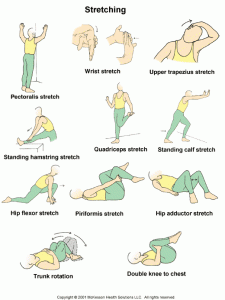
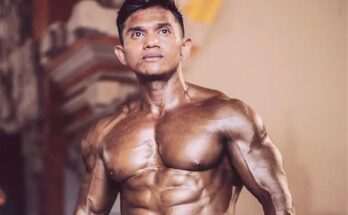
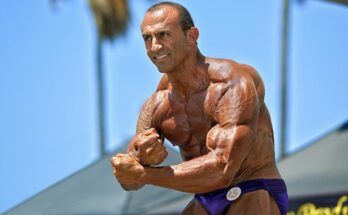
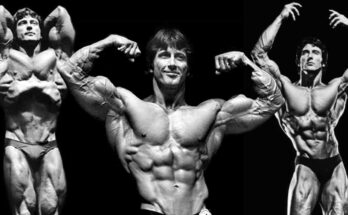
I always stretch after each training session.
Well, what can I say useful article with pictures. Thank you!
good read.
YEAH GOOD ONE!